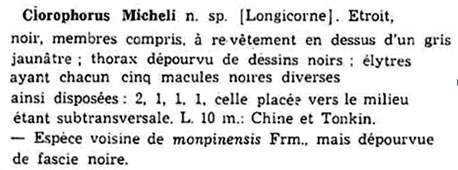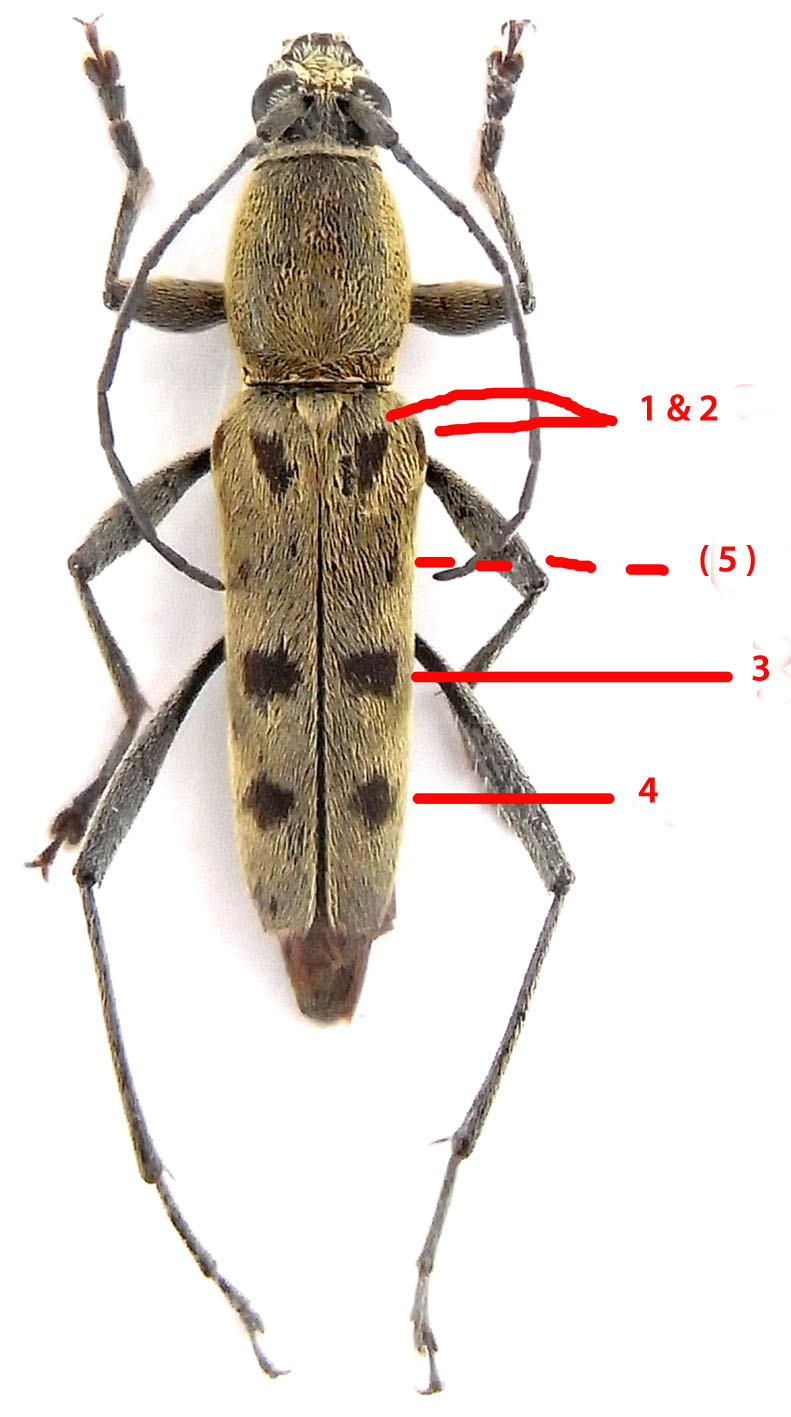| T O P I C R E V I E W |
| Xavier |
Posted - 06/09/2016 : 08:54:10

110.82 KB
1. Chlorophorus fraternus Holzschuh, 1992 Holotype. 8,9 mm / 13,5 mm. Nord Thailande, Chine.
2. Rhaphuma eleodina Gressitt & Rondon, 1970 Holotype. 9 mm / 12,7 mm. Laos, Chine (Yunnan)
 |
| 11 L A T E S T R E P L I E S (Newest First) |
| Xavier |
Posted - 30/10/2018 : 18:03:25
All answers are here !    |
| Francesco |
Posted - 01/12/2017 : 22:52:58
Exactly: In R. eleodina, the first tarsomere is "1/3 again as long as II+III", i.e.
I = 1/3 (II+III) + (II+III)
I = 4/3 (II+III)
I = 1.33 (II+III)
In other words, eloedina belongs to Chlorophorus.
And possibly, it corresponds to C. micheli and/or C. dohertii as well. |
| Xavier |
Posted - 01/12/2017 : 20:59:04
According to Gressitt & Rondon (1970)
Rhaphuma: tarsomere I more than twice II+III (that is I > 2(II+III)
It is easy to check on several species that this caractere is wrong: it could be 1,5 x longer, or 2 times longer, etc |
| Francesco |
Posted - 01/12/2017 : 20:41:39
The true problem is how to separate Chlorophorus from Rhaphuma (knowing that these genera were separated originally from Clytus arietis!)
According to Gahan (1906):
Chlorophorus: antennomere III not or scarcely longer than scape
Rhaphuma: antennomere III distinctly longer than scape
According to Gressitt (1951)
Chlorophorus: antennomere III not longer than scape
Rhaphuma: antennomere III longer than scape
According to Gressitt & Rondon (1970)
Chlorophorus: tarsomere I less than twice II+III (that is I < 2(II+III)
Rhaphuma: tarsomere I more than twice II+III (that is I > 2(II+III)
All agree on the fact that Rhaphuma has interantennal space and body narrower than Cholorophorus has, but these are relative characters...
Thus? |
| Xaurus |
Posted - 17/11/2017 : 17:28:38
sorry, you are right, very late yesterday  |
| Xavier |
Posted - 17/11/2017 : 07:49:51
No, you confuse with a Demonax that has the same species name (doherti) of Chlorophorus. |
| Xaurus |
Posted - 17/11/2017 : 01:49:45
or Demonax dohertii: http://www.cerambycoidea.com/forum/topic.asp?TOPIC_ID=18467
|
| Xavier |
Posted - 15/11/2017 : 12:03:23
La description de Rhaphuma eleodina Gressitt & Rondon, 1970 dit ceci :
"Antenna slender, reaching to apical 1/4 of elytron; segment 1 weakly arched, not quite as long as 3; 4 barely shorter than 1; 5 slightly longer than 3; 5-11 decreasing slightly in lenght.(...). Legs slender; hind tarsal segment 1 about 1/3 again as long as remainder combined"
Outre le fait que les antennes de l'holotype de R. eleodina atteignent seulement le 1/4 basal des élytres (avec une autre contradiction, puisque Gressitt écrit plus loin : "Female. Antenna reaching to middle of elytron."), ses structures antennaires et tarsales en font un Chlorophorus à mon avis. Ensuite, qu'est-ce qui le distingue réellement de C. fraternus, je ne sais pas. |
| Xavier |
Posted - 15/11/2017 : 09:39:53

Original description of Chlorophorus micheli Pic, 1950.
Of course, I do not know the holotype of C. micheli... but who knows it and who cares ? |
| Xavier |
Posted - 04/01/2017 : 14:16:31

137.26 KB
11 mm, northern Laos.
I have several specimens of this species. On this one, we can see the thorax without spot (others specimens are spotted), a very light 5th spot on elytra.
Of course, middle femora are feebly carinate along each side. |
| Xavier |
Posted - 04/01/2017 : 11:02:04
Original description of Chlorophorus dohertii (Gahan, 1906):
Black; densely covered with pubescence which is of a greenish yellow colour on the head, prothorax and elytra and of a somewhat brighter yellow colour on the body beneath; elytra marked each with four or five rather small black spots — two close to the base, one, transverse, at the middle and one halfway between the middle and the apex; the fifth spot, when present, placed a little behind the basal two; antennae and legs covered with ashy-grey pubescence. Antennae reach to the middle of the elytra in the female, to a short distance beyond it in the male; third joint subequal in length to the first and scarcely longer than the fourth, fifth subequal to the third in female, slightly longer in male. Prothorax oblongovate, not so wide in the middle as the base of the elytra. Elytra very feebly dentate at the angles of the truncate apex. Middle femora feebly carinate along each side ; hind femora extending a little past the apex of the elytra in both sexes. First joint of the hind tarsi very slightly longer than the remaining joints united.
Length 10-13 mm.
hab. Upper Burma : Ruby Mines district (Doherty).
Description of C. dohertii fits very well with both specimens above !
In his description, C. Holzschuh compared C.fraternus to Chlorophorus assimilis (Hope, 1831) which is not a species with 5 (or 4) spots on elytra (cf. Hayashi & Makihara, 1981)
It should be very interesting to see holotype specimen of C. dohertii Gahan. Does anyone have a picture ? |
|
|


